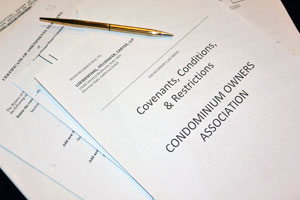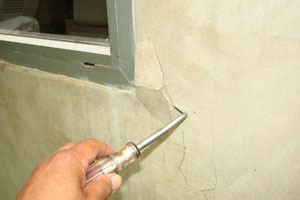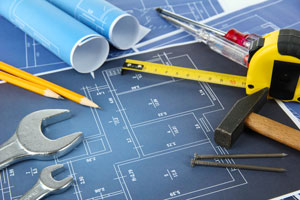The purpose of this article is to assist Board of Directors in determining whether or not they should proceed forward in filing a construction defect action involving their common interest development. For the purposes of this article, the distinction between Civil Code §1375, also known as the Calderon Act, and the ultimate filing of a lawsuit are not generally discussed. Rather, this article focuses on the benefits and detriments in proceeding forward in filing a claim/action against a developer/builder for the Association as a whole.
Embarking on a path toward a possible defect lawsuit is an unenviable task for a Board of Directors since your actions will effect all of your members. Generally, you will have those supporters in the Association who believe that your decision was correct in pursuing a defect lawsuit; whereas, there will be other homeowners who believe that such action has been detrimental to the Association as a whole. In balancing the issue of whether or not to pursue a defect action, there are several issues that a Board of Directors should take into consideration, which are as follows:
(1) What are the nature of the defects? The Board of Directors needs to evaluate whether the project is suffering real defects as opposed to simply perceived defects. As an example, are homeowners complaining of roof and window leaks; thin walls where they can hear every breath of their neighbor; substantially cracked streets and driveways or, are the complaints limited to dissatisfaction of an interior paint color, carpeting stretch marks, etc. Such an initial evaluation should be performed via homeowner surveys that are provided to each member of the Association for their completion by the Association s attorney. It is important that the survey be generated by the attorney so as to preserve attorney-client and work product privileges.
(2) What is the viability of the defendants? Assuming that the Association has real defects, then the next issue that the Board of Directors must consider is whether or not there are viable defendants to proceed against in a defects lawsuit. Specifically, is the developer, general contractor, subcontractors and design professionals still in business; are they insured; will they likely proceed into bankruptcy if you file a lawsuit against them. Though it is generally difficult to determine precisely the viability of a developer/general contractor, several avenues can in fact be investigated prior to the commencement of a claim/action. As an example, periodically, the Los Angeles Times publishes a survey of residential builders, which identifies the fifty (50) largest builders in Southern California by number of units built, revenue, etc. If the developer/general contractor involved in your particular Association is on this list, there is at least, at a minimum, a higher likelihood that this developer/general contractor is still in business and has assets. In addition, the fact that they are large enough to be represented on this developers list, will likely increase the chances that they have appropriate insurance to cover them for a construction defect lawsuit.
If, on the other hand, the developer of your particular project is small, you can still contact the Secretary of State, Department of Corporations to determine whether or not the corporation is in good standing or whether or not it has been suspended for various reasons, including failure to pay franchise taxes.
Again, the above is not a full proof system to determine the viability of the developer; however, it will provide you certain avenues in which to research this issue.
(3) How will the Association finance the defects lawsuit? Assuming the that Association, via its Board of Directors or membership, opines that it is worthwhile to proceed forward against a developer, then the next issue that must be addressed is how to finance this litigation. As many Board of Directors have learned much to their dismay, construction defect lawsuits can be very costly in both time and money. Therefore, it is critical that the Association obtain the services of a law firm who will attempt to tailor the Association s financial needs and resources into a retainer agreement that is acceptable to both the Association and to the law firm by means of either an hourly fee or contingency fee. Associations should be apprised that fee arrangements between themselves and the law firm are not set by statute, but are rather negotiated contracts.
If an Association wishes to proceed forward in performing a defect lawsuit on an hourly basis, this can be accomplished in several manners, including, but not limited to, the Association directly paying for the fees and costs on a monthly basis via their own resources; the Association obtaining a bank loan to pay for the fees and costs; or the Association special assessing its members to pay for such costs and fees.
(4) What other options does the Association have? If the Association does in fact have real defects, then there are two (2) options which the Association can proceed upon. The first option is a defect lawsuit against the developer, subcontractors and design professionals as described herein. By proceeding with this option, the Association ultimately hopes to recover sufficient funds to rectify the defects that had been discovered at the project either in their entirety or to a significant extent, without the need of having additional special assessments. In the alternative, the Association could decide not to proceed against the developer and may simply internally fund, through special assessments, repairs to the Association as they are discovered and manifest themselves. Simply stated, the Association could either attempt to have the wrongdoer, i.e. the developer pay for the defects, or the Association, as the innocent victim, can determine to internally finance such repairs.
(5) What are the detriments to having a construction defects lawsuit?
As stated above, there are pros and cons in the decision of proceeding forward in a defect lawsuit. In addition to the fact that certain homeowners may not be in favor of engaging in a defect lawsuit, another issue pertains to the viability of selling a unit during a lawsuit. Specifically, it is likely that during the pendency of a lawsuit, homeowners will have a greater difficulty in selling their unit for full market value or refinancing the unit. However, again, if the Association opts not to file a defects lawsuit, but are aware of the existence of defects, the individual sellers will still have to disclose such defects to potential buyers. In addition, the unit seller will also have to disclose the fact that there is a likelihood of special assessments being levied to pay for the repair of such defects, which will also likely effect the marketability of the residence.
(6) How long will a construction defect lawsuit take? As of January, 1996, California law, pursuant to Civil Code §1375, now requires that an Association, prior to the filing of a construction defect lawsuit, must attempt to informally settle their claim with the developer through a process of testing, settlement demands, meetings, etc. This process can generally last ninety (90) to one-hundred twenty (120) days, unless the developer opts not to participate, in which case the Association is then free to proceed forward in filing a defects lawsuit. Generally, defect actions do not resolve themselves in this interim period; therefore, the Association upon making a decision, must act under the auspice that this matter will in fact proceed to a lawsuit. In California, cases must be brought to trial within five (5) years. However, well handled construction defect cases often resolve via the use of mediation and Case Management Orders in a much shorter period of time, possibly fourteen (14) to twenty-four (24) months. Though this may still seem like a significant period of time, at the end of such a time, if a settlement is reached, the Association should hopefully be in a position to rectify most of the deficiencies that they have discovered and have had all or most of the repairs paid for by the developer and subcontractors, as opposed to by the Association via special assessments against their own membership.
Also, in evaluating an attorney, you should determine whether or not the attorney will still be around as your counsel after the defect lawsuit is over, i.e., is the law firm a full service Homeowners Association law firm with a specialty in construction defect litigation. This is of great importance in that a full service Association law firm will likely wish to remain with the Association even after the defect lawsuit is completed, by assisting in negotiating the construction contracts for the repairs, participating in the bidding process with the new contractors and generally acting as your general counsel for those items that will exist for the Association after the defect lawsuit is simply a memory.
(7) How to determine which law firm to retain? In determining which law firm you should retain in a defect lawsuit, several items should be considered, including knowledge and experience in the area of the law; track record; importance of the Association as a client to the law firm; a willingness to act zealously on behalf of the client; and most importantly, understanding whom from the law firm will actually be handling the case. Again, choosing a law firm is not an exact science, but it is important that the Board of Directors selects an attorney or law firm that they feel comfortable with; that they believe is competent to do the work and in general fits the chemistry of the Association as a whole. Remember, the Board of Directors will be working very closely with the law firm and especially the handling attorney for possibly a number of years and therefore, the creation of this relationship is critical.
Again, there are numerous factors which a Board of Directors must consider prior to commencing a construction defect lawsuit. However, the ultimate issue that the Board of Directors must decide is whether it is prudent for the Association to pay directly for remediation of defects, as opposed to attempting to have the developer/builder pay for such repairs. Generally, it is in the Association’s best interest to have a developer/builder pay for either all or the majority of the repairs rather than taxing the Association’s own membership to perform such repairs.


